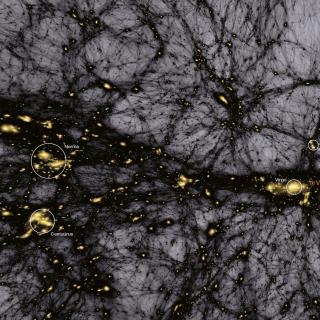Bibcode
von Marttens, R.; Marra, V.; Quartin, M.; Casarini, L.; Baqui, P. O.; Alvarez-Candal, A.; Galindo-Guil, F. J.; Fernández-Ontiveros, J. A.; del Pino, Andrés; Díaz-García, L. A.; López-Sanjuan, C.; Alcaniz, J.; Angulo, R.; Cenarro, A. J.; Cristóbal-Hornillos, D.; Dupke, R.; Ederoclite, A.; Hernández-Monteagudo, C.; Marín-Franch, A.; Moles, M.; Sodré, L.; Varela, J.; Vázquez Ramió, H.
Bibliographical reference
Monthly Notices of the Royal Astronomical Society
Advertised on:
1
2024
Citations
10
Refereed citations
9
Description
The Javalambre Photometric Local Universe Survey (J-PLUS) is a 12-band photometric survey using the 83-cm JAST telescope. Data Release 3 includes 47.4 million sources. J-PLUS DR3 only provides star-galaxy classification so that quasars are not identified from the other sources. Given the size of the data set, machine learning methods could provide a valid alternative classification and a solution to the classification of quasars. Our objective is to classify J-PLUS DR3 sources into galaxies, stars, and quasars, outperforming the available classifiers in each class. We use an automated machine learning tool called TPOT to find an optimized pipeline to perform the classification. The supervised machine learning algorithms are trained on the crossmatch with SDSS DR18, LAMOST DR8, and Gaia. We checked that the training set of about 660 thousand galaxies, 1.2 million stars, and 270 thousand quasars is both representative and contain a minimal presence of contaminants (less than 1 per cent). We considered 37 features: the 12 photometric bands with respective errors, 6 colours, 4 morphological parameters, galactic extinction with its error, and the PSF relative to the corresponding pointing. With TPOT genetic algorithm, we found that XGBoost provides the best performance: the AUC for galaxies, stars, and quasars is above 0.99 and the average precision is above 0.99 for galaxies and stars and 0.96 for quasars. XGBoost outperforms the classifiers already provided in J-PLUS DR3 and also classifies quasars.
Related projects

Cosmology with Large Scale Structure Probes
The Cosmic Microwave Background (CMB) contains the statistical information about the early seeds of the structure formation in our Universe. Its natural counterpart in the local universe is the distribution of galaxies that arises as a result of gravitational growth of those primordial and small density fluctuations. The characterization of the
FRANCISCO SHU
KITAURA JOYANES